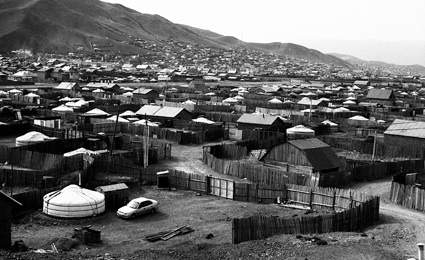3 Exhibitions
Landscapes, paper in porcelain and a lot of tents.
Overview
Raphael Morgan’s documentary photos Wild Mongolia are the star of the current three exhibitions at Gaffa. They take us across modern Mongolia itself — the most sparsely populated in the world — introducing us to herders, their families, flocks and lives. Within China's borders, an autonomous region called Mongolia strikes tensions of city versus nomad kind. Morgan's subject is the neighbouring, independent country of the same name. This Mongolia also also has a city/country divide, as minerals draw many of its citizens from a nomadic life to a growing slum around the capital Ulaanbaatar. Morgan’s photo work bridges both worlds, though this exhibition focuses more on the nomad life than that of the slum.
It's Mongolian, it’s dusty and it’s in black and white. But this is a cowboy story. Morgan’s lens tracks lone riders lopes by dirt plains and rolling dry hills, settles on a stallion whose manes stoops to its knees and focuses on babysitting and babysat children, watching the world with wide jaws or stone-mouthed seriousness. Another child toddles in with the sheep.
Mongolian tents are a big feature. While a Tsaatan teepee (and owner) gets a mention, most of these pictures are of low, circular gers (aka tents). One photo makes its ger look like nothing so much as a hobbit house let loose on a plain. Round, low-ceilinged, a small chimney and a squat (square) door at front.A bike and a motorbike lean against the side. Another photo of the same ger shows a solar panel on the roof and a satellite dish. Low, dusty hills roll away.
More tents flock at a slum outside Ulaanbaatar. This slum looks something between a camping ground, a field of back sheds and a low-rise favela. Houses crawl up the hills in the background and spiny, wooden fences are everywhere. Though made of entirely familiar elements, this vista is unlike other places. What does it mean when nomadic people build a temporary slum? Is it easier for them to move on? Or, leaving their herds behind, are they as trapped as anyone else?
Meanwhile, Susan Severino’s landscapes are the macro made micro. Here she studies mainly the tips mountains and ravines, taking one close-up snippet of her subject per canvas, like God’s collage-maker. Her mountain tops run like spines across the middle of her best canvases. Her colours are rich, impressionistic and at their best shine brilliantly. But some of the softer, less defined picture are less successful. And Hayden Youlley’s Paper Series sets out a small selection of porcelain cups and bowls, crumpled like paper at the base. It’s not a new trick, but it’s a good one. His work has the obligatory and appealing contrast between what the eye sees and what the hand expects.
Photo: Mongolia 10 by Raphael Morgan.





